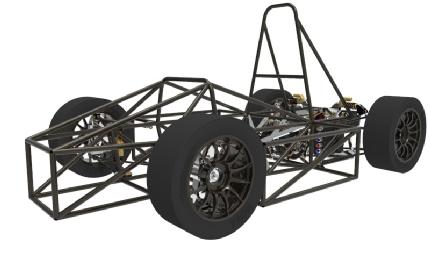WMG News - Latest news from WMG
Warwick Racing Engineering Team unveils its production during COVID
While the Summer months are used for relaxing and revision for most students, a group of students who form Warwick Racing stayed behind to continue their work on the single-seater electric race car, ready for the Formula Student events later in the academic year.
The Warwick Racing team consists of students from the School of Engineering, Warwick Business School and the Department of Computer Science, with support and facilities courtesy of WMG. The team comprises members of different gender, race, nationality and degree, with an expansion to the business team in term one adding 12 additional new members to the fold, overseeing the website, marketing and social media.
Due to the pandemic the students worked remotely to design the second race car, WRe2. But as labs reopened over the summer it was time to start putting  the real-world production of components into action.
the real-world production of components into action.
Following social distancing guidelines, wearing protective equipment and ensuring that workstations are properly sanitized, Warwick Racing has been able to successfully ensure that component production was able to continue safely.
They were able to focus on two critical components of the car, the front upright and the wiring harness.
Watch videos documenting the creation of these two components at https://youtu.be/IF2RFvn5pYE and at https://www.youtube.com/watch?v=mSQqVBKCD5Y
Angel Marco Ansenjo, Chief Chassis Engineer at Warwick Racing comments:
“The front uprights are the real workhorses of the vehicle: holding the front wheels in place and resisting the various dynamic loads that affect the car whilst cornering, braking and moving over bumps. As such the uprights must be one of the sturdiest and most resilient parts of the whole car.
“The process of creating an upright begins in the telemetry of last year’s car. By understanding what loads are going through the car at various points in the drive, we can better design the updated component in line with the needs of the new car. From there, the entire suspension system is digitally recreated on Autodesk Fusion 360 and simulated against a variety of stresses and load combinations to test how the suspension holds up against them. These include a hard braking scenario where the steering is put on full lock and the car hits a bump at the most loaded corner of the vehicle. This is to ensure that even in the most extreme of circumstances the part remains intact and the driver is safe.”
From here, the engineers decide on many of the intricate specifics of the upright, such as deciding on the component volume, the wheel bearings and the seals. Then, the exact material for the upright is chosen in order to allow the component to perform its job in the optimal manner. In this case, the team chose to use an aluminium-silicon alloy.
Once the volume and material are chosen, the design is run through a second phase of CAD tests to optimize the efficiency of the component and to ensure that any additional weight is shed. The engineers will then re-subject the part to digital testing and produce the toolpath which is sent to the computer-controlled manufacturing machines (CNC).
Once the part has been machined, it will be cut and measured to exact specifications and the additional bracketry will be manufactured. The wheel bearings are pressed in, followed by all the mounting hardware and the wheel hub, before the component is eventually mounted onto the chassis.
The wiring harness of a race car connects and controls various electronic components of the vehicle and ensures that wires are connected in the shortest, safest and most efficient ways possible.
Rens Bossers, Chief Powertrain Engineer at Warwick Racing comments:
“The first stage of designing a wiring harness is identifying what sensors, control units and actuators need to be connected to the circuit. On the WRe2 this contains over 50 components including, but not limited to: Battery Monitoring Systems (BMS), Inverter Data, Coolant monitors, speed sensors, steering wheel position sensors, brake pressure sensors and GPS.
“Once the components are decided on, we used smart wiring software to add all the connectors in and all the shielding and seals to protect the wiring from water and dust. The system must also be designed to ensure that it can survive the vibrations and stresses of racing without braking or compromising the safety of the car. Once the design is decided upon it is refined to ensure maximum efficiency (both in terms of cost and performance) by reducing the length of wires where possible and saving weight. “
Once the digital section of the design stage is complete, the team map out the building process using a Nailboard Wiring Diagram and begin cutting and crimping the wires to motorsport grade standards. In total there are over 5 meters of wires cut for the harness and over 200 separate connections which must be individually tested and validated. Once the tests are certified, the loom is sealed to make it both waterproof and fireproof, ensuring the elements can’t get into the circuit even in the event of a crash. Once the loom is completed, it is carefully installed and secured within the chassis.
ENDS
20 JANUARY 2021
NOTES TO EDITORS
High-res images available at:
Caption: A render of WRe2 spaceframe.
Credit: Warwick Racing, University of Warwick
Video available to view at:
https://youtu.be/IF2RFvn5pYE and at https://www.youtube.com/watch?v=mSQqVBKCD5Y
Credit: Warwick Racing
For further information please contact:
Alice Scott
Media Relations Manager – Science
University of Warwick
Tel: +44 (0) 7920 531 221
E-mail: alice.j.scott@warwick.ac.uk
